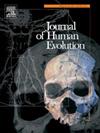New insights into the diversity of strepsirrhine primates from the late early–early middle Eocene of North Africa (Algeria and Tunisia)
IF 3.1
1区 地球科学
Q1 ANTHROPOLOGY
引用次数: 0
Abstract
The Gour Lazib Complex in Algeria and Djebel Chambi in Tunisia are the only African regions with abundant fossil records of diverse mammals dating from the late early to early middle Eocene. Among these mammals, primates, documented by few dental remains, have long attracted much attention for their possible role in the African origin of the group to which we belong, the anthropoids. Continuing fieldwork at these localities has uncovered new dental, cranial, and postcranial remains of these primates, shedding new light on their phylogenetic status. These primates, Azibiidae and Djebelemuridae, are now recognized as ‘advanced’ stem strepsirrhines, i.e., more closely related to crown Strepsirrhini (tooth-combed primates) than to any Adapiformes (other stem strepsirrhines, lacking a tooth-comb). Here, we illustrate and describe new fossil specimens (dental only) recently recovered from these two former sites. From the Gour Lazib Complex (including Glib Zegdou), in addition to the previously known azibiid taxa, Azibius trerki and Algeripithecus minutus, we describe a new, larger azibiid, Azibius magnus sp. nov., and a tiny new taxon, Lazibadapis anchomomyinopsis gen. et sp. nov., which could be a basal djebelemurid. New deciduous teeth and illustrations of earlier fossil taxa are also provided. From Chambi, in addition to Djebelemur martinezi, we identify a small azibiid, previously recognized among Djebelemur paratypes, and describe a new species, Algeripithecus minimissimus sp. nov., based on additional dental material. These new fossils extend our knowledge of the paleodiversity of these two extinct strepsirrhine families and reveal their wider paleogeographic distribution across North Africa at the onset of the Eocene. Azibiidae were highly specialized, likely feeding on a mixed diet of exudates and fruit. This specialization allowed for remarkable diversity but ultimately led to their extinction, possibly due to ecological constraints, although the factors remain unclear due to gaps in the fossil record. The less specialized Djebelemuridae, which had an insectivorous diet, lasted longer but also went extinct by the early Oligocene. These findings have significant implications for the macroevolutionary, paleobiological, and paleogeographical history of early primates in Africa during the Eocene.
北非(阿尔及利亚和突尼斯)始新世晚期-中始新世早期链球菌灵长类动物多样性的新认识
阿尔及利亚的Gour Lazib Complex和突尼斯的Djebel Chambi是非洲仅有的拥有丰富的始新世早期晚期到中期早期各种哺乳动物化石记录的地区。在这些哺乳动物中,很少有牙齿遗迹记录的灵长类动物长期以来一直备受关注,因为它们在我们所属的类人猿群体的非洲起源中可能扮演的角色。在这些地区继续进行的田野调查发现了这些灵长类动物的牙齿、颅骨和颅骨后的新遗迹,为它们的系统发育状态提供了新的线索。这些灵长类动物,Azibiidae和Djebelemuridae,现在被认为是“高级”茎链犀牛,即与冠链犀牛(有牙齿的灵长类动物)的关系比与任何Adapiformes(其他没有梳子的茎链犀牛)的关系更密切。在这里,我们说明和描述新的化石标本(牙科仅)最近从这两个前遗址恢复。在Gour Lazib复合体(包括Glib Zegdou)中,除了已知的Azibius trerki和Algeripithecus minutus之外,我们还描述了一个新的较大的Azibius magnus sp. nov.和一个新的小型分类单元Lazibadapis anchomomyinopsis gen. et sp. nov.,这可能是一个基底djebelemurid。还提供了新的乳齿和早期化石分类群的插图。在Chambi,除了Djebelemur martinezi之外,我们还发现了一种小型的阿齐biids,以前在Djebelemur副类型中被识别出来,并根据额外的牙齿材料描述了一个新物种,Algeripithecus minimissimus sp. nov.。这些新化石扩展了我们对这两个已灭绝的链球菌科的古多样性的认识,并揭示了它们在始新世开始时在北非更广泛的古地理分布。叠蚊科是高度特化的,很可能以分泌物和水果为食。这种专门化带来了显著的多样性,但最终导致了它们的灭绝,可能是由于生态限制,尽管由于化石记录的空白,原因尚不清楚。不太专门化的Djebelemuridae以食虫为食,存活时间更长,但也在渐新世早期灭绝。这些发现对研究始新世非洲早期灵长类动物的宏观进化、古生物学和古地理史具有重要意义。
本文章由计算机程序翻译,如有差异,请以英文原文为准。
求助全文
约1分钟内获得全文
求助全文
来源期刊

Journal of Human Evolution
生物-进化生物学
CiteScore
6.30
自引率
15.60%
发文量
104
审稿时长
3 months
期刊介绍:
The Journal of Human Evolution concentrates on publishing the highest quality papers covering all aspects of human evolution. The central focus is aimed jointly at paleoanthropological work, covering human and primate fossils, and at comparative studies of living species, including both morphological and molecular evidence. These include descriptions of new discoveries, interpretative analyses of new and previously described material, and assessments of the phylogeny and paleobiology of primate species. Submissions should address issues and questions of broad interest in paleoanthropology.
 求助内容:
求助内容: 应助结果提醒方式:
应助结果提醒方式:


